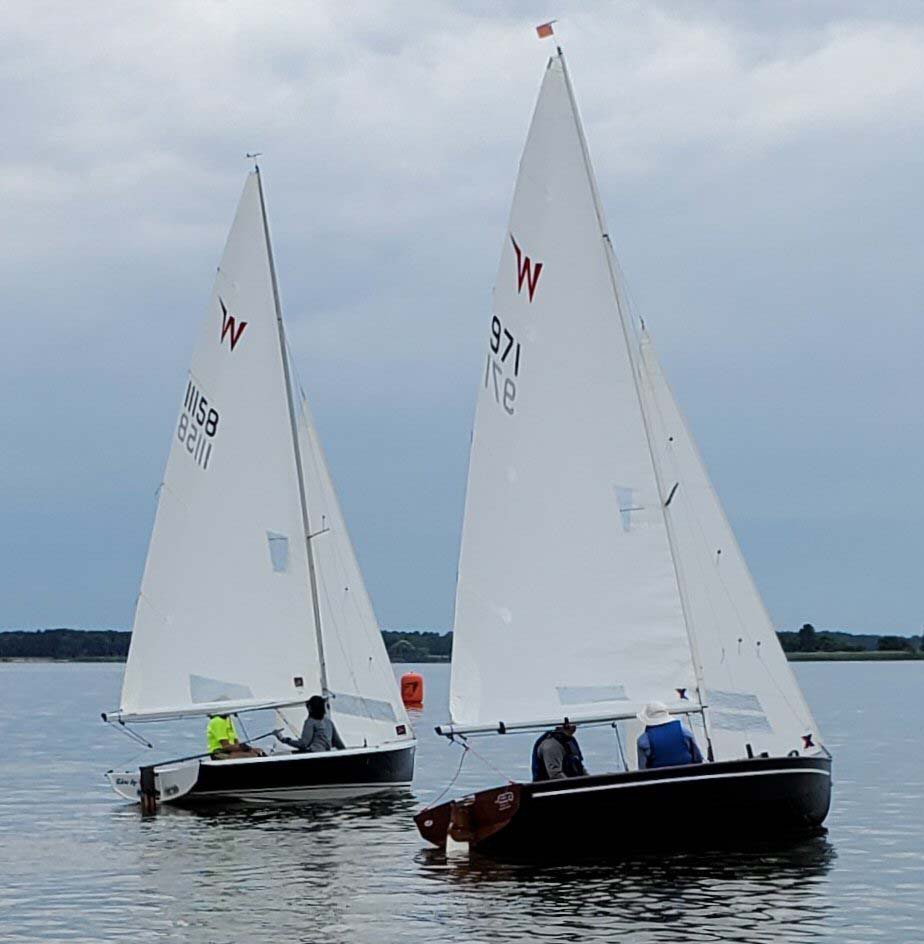| 2019 and 2021 National Champions Square off at Rock Hall By Peggy Menzies – W11158 |
 Skipper Peggy Menzies and her crew/sister, Kathy, in W11158 start against Paul
and Dawn Miller in W971 during the Rock Hall One-Design Regatta
on the Chester River June 11-12, 2022. The course racing followed the classic June 10, 2022 Rock Hall Downriver Race. Photo courtesy of RHYC As the second leg of what’s been dubbed the Wayfarer Quadruple Challenge (Down River Race, Rock Hall One-Design Regatta, Chesapeake Bay Cruise and Governor’s Cup), this year’s Rock Hall One-Design Regatta at Rock Hall Yacht Club was a head-to-head match-up between a Mark 1 woodie and a Mark 4 glassie; a husband-wife team (Paul and Dawn Miller) and a sister team (myself and Kathy Sanville); a pin-end starter and a boat-end starter; a New Englander and a Mid-Westerner; new Mike Mac sails and older Hartley sails. For W11158, it was also the first time in – dare I say it – brackish water??? Oh, my virgin boat. We were supposed to have a four boat fleet. But Al (Schonborn W3854), after injuring his arm in the Down River Race, wisely chose to return home, and the local Wayfarer bowed out, cutting our four-boat class in half. The course was simple windward-leewards with downwind finishes – no gates, sometimes once around, sometimes twice. But don’t forget about the offset mark. There were four fleets starting: First the Windmills, having their District Championships, then the Hamptons, followed by the Comets, having their National Championships, leaving us two lovely (lonely?) Wayfarers to start by ourselves. On Saturday, the winds were light and variable, the more so as the day rolled on. The first race start, as with every race start after, was easily won by none other than Paul Miller of the “reckless” starter fame from the Wayfarer International Championships at Lake Eustis, Fla. Clearly after the Internationals, Paul has recovered from his painful bout of OCS syndrome. No recalls for Wayfarer starts and certainly not for me from the second row. However, those flat-entry Hartley sails provided excellent pinching ability and soon, I was in the lead for much of the race. Never for long though. I was soon overtaken on the down wind when Dawn and Paul took a shortcut – much like in the downriver race. Unfortunately, in this race, the shortcut (bypassing the offset mark) was frowned upon by the Race Committee and they were awarded a DNF. The next race was even lighter air with a huge shift. At the weather mark, a nearly last place Comet was having fits and was very upset having to give mark room to a Wayfarer (when in fact he needed to give mark room to both of us). Kathy and I opted to avoid his one-sided screaming fit and sailed well to leeward as we were able to pass behind. Lucky for us, another Comet decided to luff Dawn and Paul before the finish as a puff from behind was approaching. Thank you Comet fleet, another undeserved first for me. The race committee then called racing for the day as more wind was forecast for Sunday. We spent a lovely afternoon swapping stories while watching Paul tweak 971. He is struggling to update the old boat from its 1983 configuration to a modern tune compatible with the latest Mac sails. He felt Saturday was possibly a step forward, but Sunday he may have tweaked the boat a step backwards. “Patience, my young Padawan.” (says Paul). It truly was a delightful afternoon, and that evening the Rock Hall Yacht Club had a splendid Italian dinner for all of us. After an evening of spectacular thunderstorms that shook our tents and tested waterproofing, we rose to what looked to be marginal conditions, but turned into the perfect racing day. We had a fresh breeze with some white caps at times, but I wouldn’t have called it heavy air. We managed four more windward-leeward races, Dawn and Paul winning every start (will I ever learn how to start at the pin in a match race??? ). Then, jockeying for position and boat speed throughout the course, we swapped places back and forth. At the end of six races, I had six wins and Paul five seconds and a throw-out. It was fun, it was challenging, and I think we both learned a lot about how to make our boats go faster. I know I spent a lot of time looking at Paul’s transom going down wind. Getting my stern out of the water in medium to light air to reduce wetted surface was so key to improving speed off the air. Pole height was pretty key too. Dawn is a master flier. Upwind it was playing body weight, vang, bridle, and jib and main tension through the three-to-four-foot wave pattern known as the Chesapeake chop, then knowing when to pinch then foot. Couldn’t have done it without my sister, Kathy, who flew in from Minnesota – likely the farthest participant. |